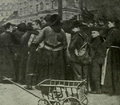Blockade of Germany facts for kids
The blockade of Germany was a big naval operation during World War I. It was part of the First Battle of the Atlantic and involved the United Kingdom and Germany.
The British navy started a blockade against Germany early in the war. This meant they tried to stop ships from bringing supplies into Germany. The German navy, even after big battles like the Battle of Jutland, couldn't break this blockade. What made this blockade unusual was that it even stopped food from reaching Germany. The Germans felt this was an attempt to starve their people. In response, Germany tried to blockade Britain and France.
Germany's navy wasn't as strong as the British Royal Navy. So, the only way Germany could try to blockade Britain was by using submarines, also known as U-boats. At first, the Chancellor of Germany was against this. He worried it would mean attacking ships from neutral countries, like the United States. But the German military wanted to use submarines without limits.
On 4 February 1915, Kaiser Wilhelm II of Germany announced that the waters around the British Isles were a war zone. This meant that from 18 February, Allied ships in that area could be sunk without warning. Even British ships trying to hide behind neutral flags would not be safe. However, efforts would be made to avoid sinking clearly neutral ships.
Many civilians in Germany suffered greatly because of this blockade. Up to 750,000 people might have died from starvation during the war. Even after the war ended with the Armistice in November 1918, the blockade continued into 1919. This was done to pressure Germany into signing the Treaty of Versailles in June 1919.
Contents
Fighting the Blockade
German U-Boat Attacks
The German U-boat force was mainly based in Ostend, Belgium. This gave them better access to the shipping lanes around England. Germany used this advantage and sent out about 20 U-boats to start their naval blockade. Before this "unrestricted submarine warfare" began, U-boats had sunk about 43,550 tonnes of shipping in January. The number of sinkings then grew steadily, reaching 168,200 tonnes in August.
British Response
The British navy lost few warships to U-boats. While the battleship Formidable was sunk by U-24 on New Year's Day, fast destroyers soon made it hard for U-boats to attack battleships and cruisers. It was also very difficult for a Royal Navy warship to sink a U-boat once it had submerged. A U-boat was generally safe from shelling underwater. It could be rammed if it was near the surface, but ramming was not a common tactic.
Destroyers were busy protecting the main fleet, so they couldn't hunt U-boats much. The British used every vessel they could, including yachts and fishing trawlers, as patrol boats. But the U-boats could often avoid these patrols and sink merchant ships traveling alone.
Impact on Public Opinion
From a military point of view, unrestricted submarine warfare was very successful. It seemed like the U-boats might starve Britain into surrendering. However, it was a big disaster for Germany in terms of propaganda. America wanted to stay out of the European war. But American public opinion turned against Germany because the unrestricted submarine warfare seemed cruel. News of American citizens dying on British ships sunk by U-boats made headlines in the US.
On 7 May 1915, a German submarine sank the passenger liner RMS Lusitania. This made Americans very angry and brought the US closer to declaring war on Germany. Because of the threat of US action, the Kaiser placed strict limits on U-boat attacks against large passenger ships on 27 August. Then, on 18 September 1915, he completely stopped unrestricted submarine warfare.
Return of Unrestricted Warfare
Under military pressure in Germany, the Kaiser declared full unrestricted submarine warfare again in early 1917. Some German diplomats thought Americans would avoid war at all costs. If not, they hoped Germany could defeat Britain before American power made a difference in Europe. In February, 86 vessels were sunk, followed by 103 in March, and then 155 in April. The US finally declared war on Germany in April 1917, partly because of the Zimmermann Telegram. Together, America and Britain were able to defeat the U-boats.
Images for kids



